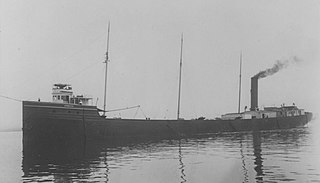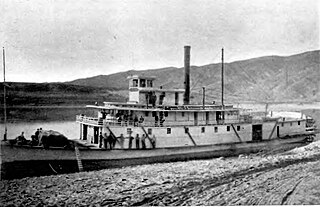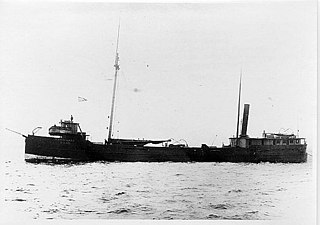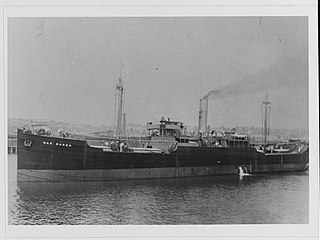Related Research Articles

SS Valencia was an iron-hulled passenger steamer built for the Red D Line for service between Venezuela and New York City. She was built in 1882 by William Cramp and Sons, one year after the construction of her sister ship Caracas. She was a 1,598-ton vessel, 252 feet (77 m) in length. In 1897, Valencia was deliberately attacked by the Spanish cruiser Reina Mercedes off Guantanamo Bay, Cuba. The next year, she became a coastal passenger liner on the U.S. West Coast and served periodically in the Spanish–American War as a troopship to the Philippines. Valencia was wrecked off Cape Beale, which is near Clo-oose, on the west coast of Vancouver Island, British Columbia, on 22 January 1906. As her sinking killed 100 people, some classify the wreck of Valencia as the worst maritime disaster in the "Graveyard of the Pacific", a famously treacherous area off the southwest coast of Vancouver Island.

The SS Appomattox was a wooden-hulled, American Great Lakes freighter that ran aground on Lake Michigan, off Atwater Beach off the coast of Shorewood, Wisconsin in Milwaukee County, Wisconsin, United States in 1905. On January 20, 2005 the remnants of the Appomattox were listed on the National Register of Historic Places.

Steamboats on the Columbia River system were wrecked for many reasons, including striking rocks or logs ("snags"), fire, boiler explosion, or puncture or crushing by ice. Sometimes boats could be salvaged, and sometimes not.

The sternwheeler Multnomah was built at East Portland, Oregon in 1885 and operated on the Willamette and Columbia Rivers until 1889 in the United States. She was later transferred to Puget Sound and became one of the better known steamboats operating there.

Flyer was an American steamboat that served from 1891 to 1929 on Puget Sound. From 1918 until the end of her service, she was officially known as the Washington. The Flyer ran for millions of miles at high speed, more than any inland vessel in the world. This 1891 steamer Flyer should not be confused with the steamboat Flyer built on Lake Coeur d'Alene in 1905, although the Coeur d'Alene vessel was inspired both in design and name by the success of the Puget Sound ship.

Annie Faxon was a steamboat that was built by the Oregon Steam Navigation Company. She is chiefly remembered now for the catastrophic boiler explosion in 1893 that destroyed her and killed eight people on board.

Boiler Bay State Scenic Viewpoint is a state park in the U.S. state of Oregon, administered by the Oregon Parks and Recreation Department. The park is one mile (1.6 km) north of Depoe Bay, Oregon.

SS Myron was a wooden steamship built in 1888. She spent her 31-year career as lumber hooker, towing schooner barges on the Great Lakes. She sank in 1919, in a Lake Superior November gale. All of her 17 crew members were killed but her captain survived. He was found drifting on wreckage near Ile Parisienne. Her tow, the Miztec, survived. Myron defied the adage that Lake Superior "seldom gives up her dead" when all 17 crewmembers were found frozen to death wearing their life jackets. Local residents chopped eight of Myron's sailors from the ice on the shore of Whitefish Bay and buried them at the Mission Hill Cemetery in Bay Mills Township, Michigan.
Sea Witch was a MARAD Type C5-S-73b container ship built at the Bath Iron Works shipyard for American Export-Isbrandtsen Lines. She operated in the Atlantic trades for five years. So engaged on the evening of June 1, 1973, the vessel was involved in a disastrous collision with the oil tanker Esso Brussels in lower New York Harbor and was damaged so badly that she was removed from active service.

SS Columbia (1880–1907) was a cargo and passenger steamship that was owned by the Oregon Railway and Navigation Company and later the San Francisco and Portland Steamship Company. Columbia was constructed in 1880 by the John Roach & Sons shipyard in Chester, Pennsylvania for the Oregon Railway and Navigation Company.

R. J. Hackett was a steamer built in 1869. When first launched, the ship's wide cross-section and long midships hold were unconventional, but the design's advantages in moving cargo through the inland lakes spawned many imitators. The Hackett is recognized as the first Great Lakes freighter, a vessel type that has dominated Great Lakes shipping for over 100 years. In 1905, the Hackett caught fire and sank on Whaleback Shoal in Green Bay, 9.5 miles (15.3 km) southeast of the Cedar River in Menominee County, Michigan. The wreck site was listed on the National Register of Historic Places in 1992.
W.H. Harrison was a steam schooner that operated from 1890 to 1905 on the coast of Oregon, the lower Columbia River, and southwest Washington state. At that time the salmon cannery industry was one of the major businesses of the coast. W.H. Harrison, while also carrying passengers and transporting general freight and lumber, was one of a number of steamers supplying materials to canneries along the coast, and transporting cases of canned salmon from the canneries.

George R. Vosburg was a steam tug that operated from 1900 to 1912 on the Columbia River and the north coast of Oregon south from Astoria to the Nehalem River and Tillamook City. Generally called the Vosburg in practice, and referred to as Geo. R. Vosburg in official records, this vessel performed many tasks, from carrying cargo and passengers, and towing barges of rock for jetty construction. After 1925, this vessel was renamed George M. Brown, and was converted to diesel power. Under the name George M. Brown, this vessel remained in service until 1968 or later.

The SS Drexel Victory was a Victory-class cargo ship built during World War II. The SS Drexel Victory (MCV-712), was a type VC2-S-AP2 victory ship built by Permanente Metals Corporation, Yard 2, of Richmond, California under the Emergency Shipbuilding program. The Maritime Administration cargo ship was the 744th victory ship. Her keel was laid on February 25, 1945. The ship was christened on May 2, 1945. The ship was named in honor of Drexel University in Philadelphia, one of 150 educational institutions that had Victory ships named after them.

War Baron was a steam cargo ship built in 1916-1917 by Northwest Steel Company of Portland for Lauritz Kloster of Stavanger. The vessel was launched as Vesterlide but was renamed early in 1917 after the Cunard Line bought the vessel from their Norwegian owners. The freighter was torpedoed and sunk in January 1918 with a loss of two men.
Olockson was a steam cargo ship built in 1918–1919 by Guy M. Standifer Construction Company of Vancouver for the United States Shipping Board as part of the wartime shipbuilding program of the Emergency Fleet Corporation (EFC) to restore the nation's Merchant Marine. In March 1920, only on her second voyage, the vessel caught fire and had to be abandoned by the crew. The ship was subsequently towed to Baltimore where she was broken up in 1924.
References
- ↑ "New Steamer is Named: Olson & Mahony Decide to Call Their Schooner the J. Marhoffer". The World. Coos Bay, Oregon. 1906-10-12.
- ↑ "New Steam Schooner J. Marhoffer Will Soon be Ready for Launching". The Tacoma Daily Ledger. Tacoma, Washington. 1907-02-15.
- ↑ "Come Here for Cargoes of Fur". The Oregon Daily Journal. Portland, Oregon. 1907-07-24.
- 1 2 3 4 "Oregon Coast Shipwrecks". Archived from the original on 2009-02-18. Retrieved 2009-04-16.
Coordinates: 44°49′46″N124°03′54″W / 44.82955°N 124.06489°W